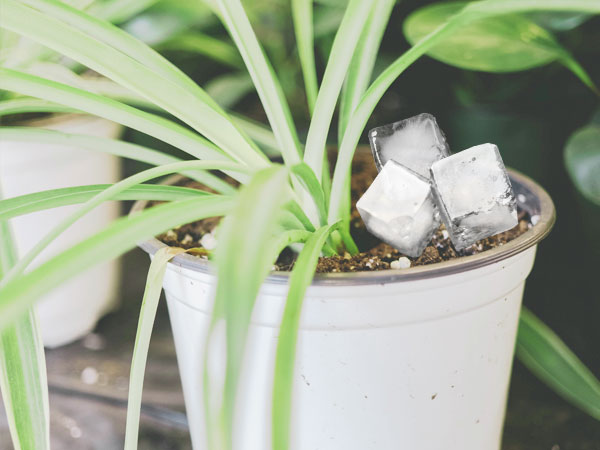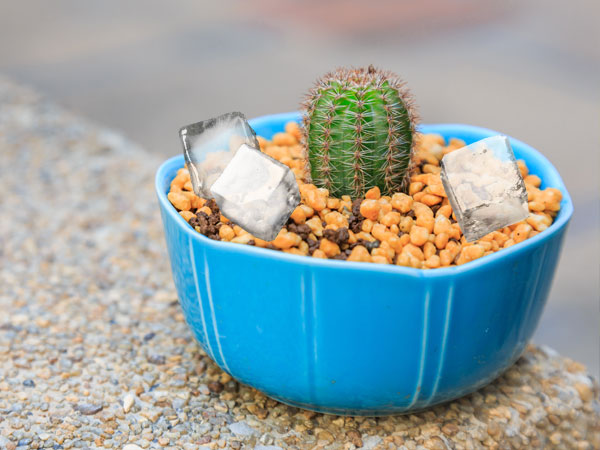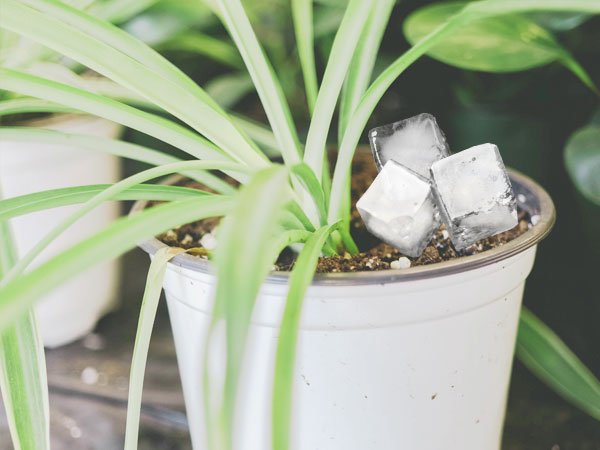As novel as the idea of watering plants with ice cubes sounds, it’s something that many seem to swear by. Experts, however, are not convinced. Hence the controversy around the subject.

What are the purported benefits of this method? And should you be relying on it to water your plants? Is it safe? Or do the downsides outweigh the benefits?
These are all questions that I too had when I first came across the subject, and now I’m sharing my findings with you to dispel some of the myths around watering plants with ice cubes
Purported Benefits of Watering Plants with Ice Cubes
If you were to go on Instagram or other similar social media site and search for ice cube orchids, you’d find quite a few images with beautiful orchids sporting healthy blooms.

Those that promote the idea of watering your plants with ice cubes cite the following benefits:
Prevents Overwatering
It’s no secret that overwatering is a top killer of many plants including orchids and other succulents.
Proponents of the ice cube watering method say that the slowly melting ice cubes give the plant time to absorb water much better.
While there may be some truth to that, it’s also important to mention that overwatering is not always about the amount of water that a plant receives at one time, it’s also about how often you water a plant.
For example, orchids enjoy a thorough watering, but it should be done infrequently. If you do this too often, you’ll of course end up overwatering.
If the soil drains well and the pot has draining holes, the excess water should get right out, and it should not be left to pool in the saucer. The next watering should happen only if the top soil dries out.
The instructions to water orchids with ice cubes that I have found, usually mention using only 2-3 ice cubes per week to water your plants.
Using so few ice cubes is of course going to prevent overwatering, but it may also provide too little water for your orchid.
Overwatering can be prevented by having a solid understanding of how much and how often you need to water a particular plant, and by examining the soil dryness and health status of your plant.
Convenience
Tossing a few ice cubes on the soil seems easier than watering plants the traditional way. But watering plants with ice cubes is a two-step process — before you can water your plants, you first need to make ice cubes.
It’s definitely a less ‘messy’ experience — no water pooling in the saucer at the bottom of the pot, no need to empty the saucer.
Kills Bacteria
It’s a common misconception that freezing water kills bacteria. Therefore, this purported benefit of watering plants with ice cubes is not something that should tilt the balance in favor of using ice cubes over regular watering.
Prevents Leaks
Watering plants in hanging baskets does come with unexpected leaks if you’re not watering these plants in a tub or outside, where leaks would not be a problem.
Ice cubes do seem to provide a better watering experience and convenience if the goal is to prevent water draining through the holes at the bottom of the hanging basket.
With the ice cube plant watering method, there is a seemingly increased contact time of the water with the soil and roots of the plant, but most houseplants do fine with a deep and thorough watering that’s done periodically.
Promotes Blooming
Another often-mentioned benefit of using ice cubes to water houseplants — especially in relation to orchids — is that the difference in temperature promotes blooming.
Orchids do indeed require a temperature difference between night and day to bloom, but it’s not exactly advisable to recreate that difference at the root level.
Orchids should not be exposed to temperatures below 60 F, let alone to ice cold water. This drop in temperature is bound to cause thermal shock and could potentially damage the plant. Orchids can even enter in a dormancy period or their growth can be slowed.
Plus, all houseplant watering guides agree that plants should be watered with room temperature water to avoid shocking the plant.
Should You Water Houseplants with Ice Cubes?
As you can see, the arguments for using ice cubes to water your houseplants become quite thin upon closer examination.
Despite the ice cube watering method having a high number of devotees, it’s also true that it isn’t a well-researched watering technique and any benefits mentioned in relation to this method are purely anecdotal.
That said, if you’re still keen on trying this method, here are a few things to watch out for:
- Don’t use this method on plants with known temperature sensitivities. The sudden change in temperature can damage the plant.
- Don’t place the ice cubes close to the stem of the plant, on its leaves or directly on its roots to avoid damaging the plant.
- Make sure that your plant is getting enough water (2-3 ice cubes for a large potted plant may not provide enough water and may only superficially water the plant, which can cause underwatering issues on the long run).
- Some advise using the ice cube watering method during extreme heat waves and drought periods.
Remember that root shock caused by using cold water on your plants may not be immediately noticeable, and it may take time for the plant to show symptoms, so closely monitor your plants.
Conclusion
While this ice cube watering trick is all the rage now, it’s important not to get carried away and carefully examine whether it’s a good idea to water your plants using this method.
Many of the claims associated with this technique don’t hold water upon closer examination and you could end up doing more harm than good.
If you’re worried about overwatering issues or convenience issues, there are alternatives that are much safer and time-tested like using self-watering pots that are both convenient and prevent overwatering issues.
If you’re going to test watering your plants with ice cubes, make sure to take the necessary precautions I discussed above.

